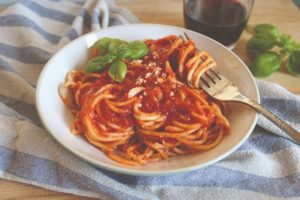It all started with the savory scent of slowly cooking garlic drifting up the street from Ciro and Sal’s restaurant. Working that summer of 1978 as a painter’s assistant in Provincetown, Hugo was almost always hungry. And it was almost always around 3:30 when the chefs and line cooks showed up to prep for dinner that the aroma began its daily crescendo. But who could afford to eat out?
Hugo started cooking in earnest. In the kitchen of the rented house he shared with a band of other hopeful artists and writers who worked as day laborers, he drew on what he remembered from home.
“I cooked what I knew,” my husband recalls. “And it always started with marinara, whether it was going to be pasta, chicken, or more pasta.”
He worked from recollected flavor, and from the impressive sight of his grandmother, known as Z’Italia, at the stove. An immense angel in a white apron, she presided over the best food he knew. He was her ready helper and kitchen companion — as Z’Italia rarely left her domain.

Naturally, Hugo’s cooking was a hit with his Provincetown roommates, as it was decades later with our family. Our kids grew up with the aroma of garlic and tomatoes luring them from homework to kitchen. No one could make marinara like Hugo.
Yet, to be honest, we all took it for granted — until a few years ago. Grown and on their own, Lucy, Amanda, and Ethan missed it. And when they launched a book project aimed at helping people cook better and spend less, they realized Hugo’s marinara was an essential recipe.
Hugo’s directions went like this: “First, don’t burn the garlic! Also, use the best tomatoes you can get.” Then, he said, “It’s all in the hand.”
The “best tomatoes” means the reddest, and, at this time of year, canned. But that last inscrutable directive, I learned by observation, is a matter of style. Hugo believes in slowly cooking the garlic in the oil and slowly stirring and combining ingredients. Tasting as you go, I learned, is part of it.
When the kids’ project began to take shape as a book, they signed Hugo on as a coauthor. They did it out of love, I’m sure, but also for his marinara. Hugo, they have come to appreciate, is a source of many culinary secrets.
True marinara is not spaghetti sauce or ragu or American marinara. This “quick sauce,” as Neapolitans call it, can be made while you cook the pasta. It centers on garlic, olive oil, tomato, and a pinch of herbs. The flavor is gentle and bright, not at all like a long-cooked, meat-infused sauce. Authentic regional variations include carrot, onion, capers, parsley, celery, olives, chile peppers, and anchovies.
In other words, this sauce is elemental.
Spurred by running a perpetual kitchen in the depths of our recent plague, I took Hugo’s marinara and ran with it. I see it now as a template for fish or shellfish, ravioli, eggplant or chicken parmigiana, lasagna, pizza, and bread soup, and, of course, as a sauce for spaghetti. It also makes an excellent flavor base for minestrone, ratatouille, and squid stew. Add cream to marinara for a romantic pink sauce to celebrate the first day of spring, a birthday, or Mother’s Day.

Hugo’s Classic Marinara
Makes 7 servings
3 Tbsp. olive oil
2 large garlic cloves, lightly smashed
1 28-ounce can whole tomatoes, preferably Italian and unsalted
Salt and pepper
Big pinch of dried basil or oregano
Optional garnish: fresh basil
Place oil in a large saucepan and turn heat to medium. When the oil shimmers, add the garlic cloves, turn the heat immediately to low, and stir for 2-3 minutes, until the cloves just begin to turn golden. Take care that they don’t burn!
Slowly add the tomatoes, starting with a large kitchen spoonful of tomato and juices. Cut and crush the tomato into the oil with the spoon. Cook for a minute before adding the remaining tomatoes and juice, crushing the tomatoes gently as you go. Stir in salt and pepper to taste, and a pinch of basil or oregano.
Bring the sauce to a slow bubble and partly cover the pan. Simmer for about 15 minutes. You can further crush the garlic cloves against the side of the pan if you wish or remove them. Give a final stir, taste for salt and pepper, and serve — at about 50 cents a serving.
Recipe adapted from The $5 Foodie: Cook Better, Spend Less, Enjoy More by Lucy Holland, Carol Rizzoli, Ethan Eron, Amanda Eron, and Hugo Rizzoli.



